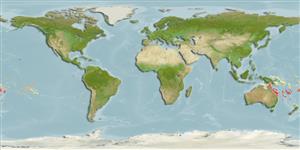>
Ovalentaria/misc (Various families in series Ovalentaria) >
Plesiopidae (Roundheads) > Plesiopinae
Etymology: Plesiops: Greek, plesios = near + Greek, ops = appearance (Ref. 45335); insularis: From the the Latin word meaning 'of islands', referring to the present distribution of the species , in the islands of the New Caledonia Basin region.
More on authors: Mooi & Randall.
Environment: milieu / climate zone / depth range / distribution range
ນິເວດວິທະຍາ
ສັດທະເລ ກ່ຽວກັນຫີນ; ລະດັບຄວາມເລິກ 0 - 25 m (Ref. 27772), usually 2 - 25 m (Ref. 27772). Temperate
Southwest Pacific: islands in the Coral and Tasman seas, including Lord Howe Island and the nearby Elizabeth and Middleton reefs, Norfolk Island, New Caledonia, and Chesterfield Bank. Western Central Pacific (Ref. 12926). Recently reported from Tonga (Ref. 53797).
ຂະໜາດ / ນ້ຳໜັກ / Age
Maturity: Lm ? range ? - ? cm
Max length : 9.8 cm SL ຕົວຜູ້/ບໍ່ມີເພດ; (Ref. 27772)
Adults inhabit coral reef (Ref. 75154) and tide pools (Ref. 27772). Benthic (Ref. 75154). Eggs are guarded by the male parent (Ref. 205).
Life cycle and mating behavior
ການຈະເລີນເຕັມໄວ | ການສືບພັນ | ການວາງໄຂ່ | ໄຂ່ | ຄວາມດົກຂອງໄຂ່ປາ | ຕົວອ່ອນ
Eggs are guarded by the male parent (Ref. 205).
Mooi, R.D., 1995. Revision, phylogeny, and discussion of biology and biogeography of the fish genus Plesiops (Perciformes: Plesiopsidae). Life Sci. Contrib. No. 159, 108 p. (Ref. 27772)
IUCN Red List Status (Ref. 130435: Version 2024-2)
Threat to humans
Harmless
Human uses
ເຄື່ອງມື
Special reports
Download XML
ແຫຼ່ງອີນເຕີເນັດ
Estimates based on models
Preferred temperature (Ref.
123201): 24.4 - 27.3, mean 26.1 °C (based on 94 cells).
Phylogenetic diversity index (Ref.
82804): PD
50 = 0.5000 [Uniqueness, from 0.5 = low to 2.0 = high].
Bayesian length-weight: a=0.01202 (0.00501 - 0.02886), b=2.98 (2.77 - 3.19), in cm total length, based on LWR estimates for this (Sub)family-body shape (Ref.
93245).
ຊັ້ນເຂດຮ້ອນ (Ref.
69278): 3.5 ±0.5 se; based on size and trophs of closest relatives
ຄວາມຢືດຢຸ່ນ (Ref.
120179): ສູງ, ປະຊາກອນຕຳ່ສຸດທີ່ໃຊ້ເວລາສອງໜ້ອຍກວ່າ 15 ເດືອນ (Preliminary K or Fecundity.).
Fishing Vulnerability (Ref.
59153): Low vulnerability (10 of 100).
Nutrients (Ref.
124155): Calcium = 37.8 [14.8, 72.2] mg/100g; Iron = 0.269 [0.144, 0.487] mg/100g; Protein = 19.2 [18.1, 20.3] %; Omega3 = 0.427 [0.215, 0.862] g/100g; Selenium = 4.43 [1.88, 10.37] μg/100g; VitaminA = 120 [30, 489] μg/100g; Zinc = 0.876 [0.547, 1.371] mg/100g (wet weight);
